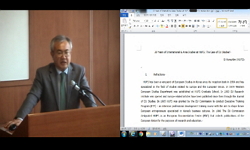The South Asian Association of Regional Cooperation (SAARC) marked its Silver Jubilee in 2010. The SAARC`s charter, which was signed by Bangladesh, Bhutan, India, the Maldives, Nepal, Pakistan, and Sri Lanka in 1985, has many similarities to the found...
http://chineseinput.net/에서 pinyin(병음)방식으로 중국어를 변환할 수 있습니다.
변환된 중국어를 복사하여 사용하시면 됩니다.
- 中文 을 입력하시려면 zhongwen을 입력하시고 space를누르시면됩니다.
- 北京 을 입력하시려면 beijing을 입력하시고 space를 누르시면 됩니다.


Economic Integration in the Indian Subcontinent: A Study of Macroeconomic Interdependence = Economic Integration in the Indian Subcontinent: A Study of Macroeconomic Interdependence
한글로보기https://www.riss.kr/link?id=A99553697
-
저자
( T K Jayaraman ) (The University of the South Pacific) ; ( Chee Keong Choong ) (Universiti Tunku Abdul Rahman)
- 발행기관
- 학술지명
- 권호사항
-
발행연도
2012
-
작성언어
Korean
- 주제어
-
KDC
322.8
-
등재정보
KCI등재,SCOPUS,ESCI
-
자료형태
학술저널
- 발행기관 URL
-
수록면
584-608(25쪽)
-
KCI 피인용횟수
0
- 제공처
- 소장기관
-
0
상세조회 -
0
다운로드
부가정보
다국어 초록 (Multilingual Abstract)
The South Asian Association of Regional Cooperation (SAARC) marked its Silver Jubilee in 2010. The SAARC`s charter, which was signed by Bangladesh, Bhutan, India, the Maldives, Nepal, Pakistan, and Sri Lanka in 1985, has many similarities to the founding charters of similar regional associations signed elsewhere. While other regional associations have made substantial progress, SAARC has yet to produce notable results. In the context of growing global economic interdependence, it is of interest to assess how far economic growth in each of the SAARC economies has influenced growth in other member countries. Adopting a vector autoregression (VAR) methodology, this paper investigates macroeconomic interdependence in the South Asian region with a view to evaluating its readiness to forge ahead with its integration efforts. The findings of the study reveal that India has been influencing economic growth in the region, as its output variability has been affecting outputs in other member countries. If SAARC has to become successful as a regional bloc, India as the biggest gainer from trade and investment relationships should take some bold steps, which would represent some readiness to part with some of the gains derived by way of trade surpluses.
참고문헌 (Reference)
1 International Monetary Fund, "World Economic Outlook"
2 World Bank, "World Development Indicators 2011"
3 Pitigala, N., "What Does Regional Trade in South Asia Reveal about Future Trade Integration? Some Empirical Evidence" World Bank 2005
4 Jha, S., "Utility of Regional Trade Agreements: Experience of India’s Regionalism" Asia Pacific Research and Training Network on Trade 2011
5 UN ESCAP, "UN ESCAP Statistical Data Base, 2011"
6 Jain, R., "Trade Pattern in SAARC Countries : Emerging Trends and Issues" 30 (30): 2009
7 Mukherji, I. N., "Towards a Free Trade Area in South Asia: Charting a feasible Course for Trade Liberalization with Reference to India’s Role" RIS 2004
8 Hettne, B., "Theorizing the Rise of Regionness" 5 (5): 457-473, 2000
9 Bayoumi, T., "The Suitability of ASEAN for a Regional Currency Arrangement" 24 : 933-945, 2001
10 Desai, V., "The Political Economy of Regional Cooperation in South Asia" Asian Development Bank 2010
1 International Monetary Fund, "World Economic Outlook"
2 World Bank, "World Development Indicators 2011"
3 Pitigala, N., "What Does Regional Trade in South Asia Reveal about Future Trade Integration? Some Empirical Evidence" World Bank 2005
4 Jha, S., "Utility of Regional Trade Agreements: Experience of India’s Regionalism" Asia Pacific Research and Training Network on Trade 2011
5 UN ESCAP, "UN ESCAP Statistical Data Base, 2011"
6 Jain, R., "Trade Pattern in SAARC Countries : Emerging Trends and Issues" 30 (30): 2009
7 Mukherji, I. N., "Towards a Free Trade Area in South Asia: Charting a feasible Course for Trade Liberalization with Reference to India’s Role" RIS 2004
8 Hettne, B., "Theorizing the Rise of Regionness" 5 (5): 457-473, 2000
9 Bayoumi, T., "The Suitability of ASEAN for a Regional Currency Arrangement" 24 : 933-945, 2001
10 Desai, V., "The Political Economy of Regional Cooperation in South Asia" Asian Development Bank 2010
11 Raghuramapatruni, R., "The Experience of SAARC as a Regional Block and its Future Potentialities" 10 (10): 57-72, 2010
12 Toda, H.Y., "Statistical inference in vector autoregressions with possible nearintegrated processes" 66 : 225-250, 1995
13 Chandra, R, "South Asian Integration Prospects and Lessons from East Asia" Indian Council for Research on International Economic Relations 2008
14 Panagariya, A., "South Asia: Does Preferential Trade Liberalization Make Sense" 26 (26): 1279-1291, 2003
15 Delinić, T., "SAARC – 25 Years of Regional Integration in South Asia, Konrad-Adenauer-Stiftung International Reports" (2) : 721-, 2011
16 Ranjan, R., "Regional Cooperation in Asia: Status and Issues" 28 (28): 79-125, 2007
17 Baysan, T., "Preferential Trading in South Asia" The World Bank 2006
18 Ali, E., "Preferential Trade among the SAARC Countries: Prospects and Challenges of Regional Integration in South Asia" 4 (4): 47-59, 2009
19 Maskay, N. M., "Patterns of Shocks and Regional Monetary Cooperation in South Asia" International Monetary Fund 2003
20 Johansen, S., "Maximum likelihood estimation and inference on cointegration with applications to money demand" 52 : 169-210, 1990
21 Takagi, S., "Managing Macroeconomic Interdependence, Chapter 5, In Emerging Asian Regionalism" Asian Development Bank 2008
22 Bayoumi, T., "Macroeconomic Shocks and Trade Flows within Sub-Saharan Africa: Implications for Optimum Currency Arrangements" 6 : 412-444, 1997
23 Kawai, M., "Macroeconomic Interdependence in East Asia: Empirical Evidence and Issues, In Asian Economic Cooperation and Integration" Asian Development Bank 213-268, 2005
24 Ng, S., "Lag Length Selection and the Construction of Unit Root Tests with Good Size and Power" 69 : 1519-1554, 2001
25 De Lombaerde, P., "Indicators of Regional Integration: Conceptual and Methodological Issues" IIIS 2005
26 BBC, "Indian PM Singh ends Bangladesh trip without key deals"
27 Jayanthakumaran, K., "Income Convergence of the SAARC-5 Countries" 8 (8): 367-386, 2009
28 Aftab, M., "If trade flows big, can peace be far behind?"
29 Bandara, J. S., "How Desirable is the South Asian Free Trade Area? A Quantitative Economic Assessment" 26 (26): 1293-1323, 2003
30 Hettne, B., "Globalization and the New Regionalism: The Second Great Transformation, In Globalism and the New Regionalism" MacMillan Press 1-24, 1999
31 Mohan, N. C., "From Bangladesh to BIMSTEC"
32 Akanda, A., "Economic Integration of SAARC Countries"
33 Bhuyan, A. R., "Economic Integration in South Asia : An Exploratory Study" The University of Dhaka 1979
34 Bhuyan, A. R., "Economic Effects of South Asian Free Trade Area on Intra-regional Trade and Investment" 18 (18): 7-35, 2008
35 Jayaraman, T. K., "Economic Cooperation in the Indian Subcontinent : A Customs Union Approach" Orient Longman 1978
36 Chowdhury, K., "Convergence of Per Capita GDP across SAARC Countries" School of Economics, University of Wollongong 2004
37 Saxena, S. C., "Can South Asia Adopt a Common Currency?" 16 : 635-662, 2005
38 Wadhwa, D., "Assessing the Potential for Growth of Intra-Regional Trade in South Asia" 2010
39 Enders, W., "Applied Econometric Time Series" John Wiley & Sons 1995
40 Lamberte, M. R., "An Overview of Economic Cooperation and Integration in Asia, In Asian Economic Cooperation and Integration" Asian Development Bank 3-44, 2005
41 Mundell, R., "A Theory of Optimum Currency Area" 51 : 657-665, 1961
42 Low, L., "A Comparative Evaluation and Prognosis of Asia Pacific Bilateral and Regional Trade Arrangements" 18 (18): 1-11, 2004
동일학술지(권/호) 다른 논문
-
Landlocked Countries: A Way to Integrate with Coastal Economies
- 세종대학교 경제통합연구소(구 세종대학교 국제경제연구소)
- ( Bidisha Lahiri )
- 2012
- KCI등재,SCOPUS,ESCI
-
- 세종대학교 경제통합연구소(구 세종대학교 국제경제연구소)
- ( Scott W Hegerty )
- 2012
- KCI등재,SCOPUS,ESCI
-
The European Fiscal Compact: A Counterfactual Assessment
- 세종대학교 경제통합연구소(구 세종대학교 국제경제연구소)
- ( Jerome Creel )
- 2012
- KCI등재,SCOPUS,ESCI
-
Testing the Asset-seeking Hypothesis: through the Investments of Chinese and Indian Firms in Europe
- 세종대학교 경제통합연구소(구 세종대학교 국제경제연구소)
- ( He Yong )
- 2012
- KCI등재,SCOPUS,ESCI
분석정보
인용정보 인용지수 설명보기
학술지 이력
| 연월일 | 이력구분 | 이력상세 | 등재구분 |
|---|---|---|---|
| 2023 | 평가예정 | 해외DB학술지평가 신청대상 (해외등재 학술지 평가) | |
| 2020-01-01 | 평가 | 등재학술지 유지 (해외등재 학술지 평가) |  |
| 2011-06-07 | 학회명변경 | 한글명 : 국제경제연구소 -> 경제통합연구소영문명 : Center for International Economics -> Journal of Economic Integration |  |
| 2010-01-01 | 평가 | 등재학술지 유지 (등재유지) |  |
| 2008-01-01 | 평가 | 등재학술지 유지 (등재유지) |  |
| 2006-01-01 | 평가 | 등재 1차 FAIL (등재유지) |  |
| 2004-01-01 | 평가 | 등재학술지 유지 (등재유지) |  |
| 2001-07-01 | 평가 | 등재학술지 선정 (등재후보2차) |  |
| 1999-01-01 | 평가 | 등재후보학술지 선정 (신규평가) |  |
학술지 인용정보
| 기준연도 | WOS-KCI 통합IF(2년) | KCIF(2년) | KCIF(3년) |
|---|---|---|---|
| 2016 | 0.11 | 0.11 | 0.13 |
| KCIF(4년) | KCIF(5년) | 중심성지수(3년) | 즉시성지수 |
| 0.13 | 0.11 | 0.279 | 0.03 |




 KISS
KISS




